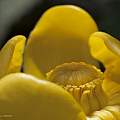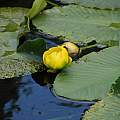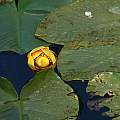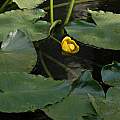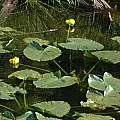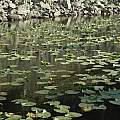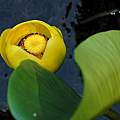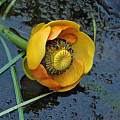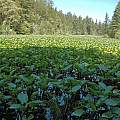Nuphar is a genus of from 1 to 25 species (usually 10-12 species) of flowering aquatic plants in the family Nymphaeaceae native to the temperate Northern Hemisphere and grow from rhizomes. Some botanists treat it as one variable species, but DNA work has shown that there are differences between the European and American species. This genus differs from Nymphaea in having its petals much smaller than its sepals, whereas in Nymphaea, the petals are much larger than the sepals. Also Nuphar fruit are held above water level until maturity, whereas Nymphaea fruit sink below the water level immediately after the flower closes.
Nuphar lutea, also known as spatterdock, is native to Eurasia and blooms during the summer months. The seeds are edible, and can be ground into flour. The rhizome is edible too but often bitter. Shlomit Heymann photographed this bloom at Nofrim Pool in Yarkon National Park, Israel, in early September 2010, an unusually late bloom. In Israel this species is critically endangered due to habitat loss. It is not endangered in European and Northern Mediterranean countries, where it is extremely common in wetlands, and it is not classified as an endangered species by the IUCN. Source: The Red Data Book: Endangered Plants of Israel
Nuphar polysepala is native to western North America where it grows in ponds, lakes, and sluggish streams. It flowers late spring to summer. It has shiny large leaves lying flat on the water and big waxy yellow flowers. Photos taken by Mary Sue Ittner and Bob Rutemoeller at Yellowstone National Park August 2009.
The photos below were taken by Bob Rutemoeller in Sonoma County on the Mendocino Sonoma Coast where a pond is completely covered with this plant. The leaves were much more upright than usual so from a distance we did not recognize it, but a closer look at the flower made the identification secure.
